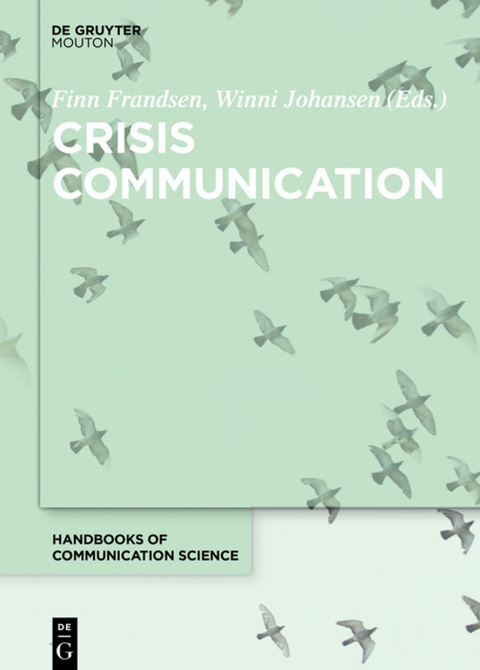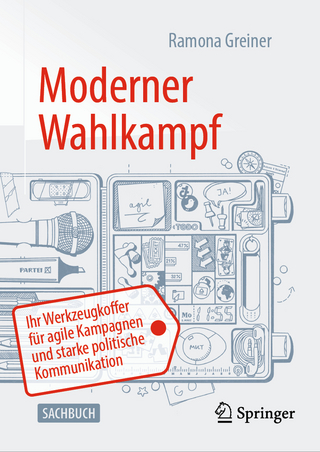Crisis Communication
Seiten
2020
de Gruyter Mouton (Verlag)
978-3-11-055228-7 (ISBN)
de Gruyter Mouton (Verlag)
978-3-11-055228-7 (ISBN)
This handbooks series aims to integrate knowledge of communication structures and processes. It is global in orientation, dedicated to cultural and epistemological diversity as well as different scholarly approaches. The series features volumes on 'messages, codes and channels', 'mode of address: communication situations and context', 'methodology in communication science' and 'application areas'. The latter features volumes devoted to a large range of specialist areas of communication science. The series as a whole aims at meeting the needs of undergraduates, postgraduates, academics and researchers across the area of communication studies.
Finn Frandsen and Winni Johansen have won the 2019 Danish communication prize (KOM-pris) for their world-class research in organisational crises, crisis management and crisis communication. This prize is awarded by The Danish Union of Journalists (Dansk Journalistforbund) and Kforum. http://mgmt.au.dk/nyheder/nyheder/news-item/artikel/finn-frandsen-and-winni-johansen-win-the-kom-pris-2019/ The aim of this handbook is to provide an up-to-date introduction to the discipline of crisis communication. Based on the most recent international research and through a series of levels (from the textual to the inter-societal level), this handbook introduces the reader to the most important concepts, models, theories and debates within the field of crisis communication. Crisis communication is a young and very vibrant field of research and practice. It is therefore crucial that researchers, students and practitioners have access to presentations and discussions of the most recent research. Like the other handbooks in the HOCS series, this handbook contains a general introduction, a chapter on the history of crisis communication research, a series of thematic chapters on crisis communication research at various levels, a chapter perspectives, a glossary of key terms, and lists of further reading for each chapter (with references to publications in English, German, and French). Overview Section I – Introducing the fieldGeneral introductionA brief history of crisis management and crisis communication: From organizational practice to academic disciplineReframing the field: Public crisis management, political crisis management, and corporate crisis management Section II – Between text and contextImage repair theorySituational crisis communication theory: Influences, provenance, evolution, and prospectsContingency theory: Evolution from a public relations theory to a theory of strategic conflict managementDiscourse of renewal: Understanding the theory’s implications for the field of crisis communicationMaking sense of crisis sensemaking theory: Weick’s contributions to the study of crisis communicationArenas and voices in organizational crisis communication: How far have we come?Visual crisis communication Section III – Organizational levelTo minimize or mobilize? The trade-offs associated with the crisis communication processInternal crisis communication: On current and future researchWhistleblowing in organizationsEmployee reactions to negative media coverageCrisis communication and organizational resilience Section IV – Interorganizational levelFixing the broken link: Communication strategies for supply chain crisesReputational interdependence and spillover: Exploring the contextual challenges of spillover crisis responseCrisis management consulting: An emerging field of study Section V – Societal levelCrisis and emergency risk communication: Past, present, and futureCrisis communication in public organizationsCommunicating and managing crisis in the world of politicsCrisis communication and the political scandalCrisis communication and social media: Short history of the evolution of social media in crisis communicationMass media and their symbiotic relationship with crisis Section VI – Intersocietal levelShould CEOs of multinationals be spokespersons during an overseas product harm crisis?Intercultural and multicultural approaches to crisis communication Section VII – Critical approachesEthics in crisis communication Section VIII – The futureThe future of organizational crises, crisis management and crisis communication For a detailed table of contents, please see here.
Finn Frandsen and Winni Johansen have won the 2019 Danish communication prize (KOM-pris) for their world-class research in organisational crises, crisis management and crisis communication. This prize is awarded by The Danish Union of Journalists (Dansk Journalistforbund) and Kforum. http://mgmt.au.dk/nyheder/nyheder/news-item/artikel/finn-frandsen-and-winni-johansen-win-the-kom-pris-2019/ The aim of this handbook is to provide an up-to-date introduction to the discipline of crisis communication. Based on the most recent international research and through a series of levels (from the textual to the inter-societal level), this handbook introduces the reader to the most important concepts, models, theories and debates within the field of crisis communication. Crisis communication is a young and very vibrant field of research and practice. It is therefore crucial that researchers, students and practitioners have access to presentations and discussions of the most recent research. Like the other handbooks in the HOCS series, this handbook contains a general introduction, a chapter on the history of crisis communication research, a series of thematic chapters on crisis communication research at various levels, a chapter perspectives, a glossary of key terms, and lists of further reading for each chapter (with references to publications in English, German, and French). Overview Section I – Introducing the fieldGeneral introductionA brief history of crisis management and crisis communication: From organizational practice to academic disciplineReframing the field: Public crisis management, political crisis management, and corporate crisis management Section II – Between text and contextImage repair theorySituational crisis communication theory: Influences, provenance, evolution, and prospectsContingency theory: Evolution from a public relations theory to a theory of strategic conflict managementDiscourse of renewal: Understanding the theory’s implications for the field of crisis communicationMaking sense of crisis sensemaking theory: Weick’s contributions to the study of crisis communicationArenas and voices in organizational crisis communication: How far have we come?Visual crisis communication Section III – Organizational levelTo minimize or mobilize? The trade-offs associated with the crisis communication processInternal crisis communication: On current and future researchWhistleblowing in organizationsEmployee reactions to negative media coverageCrisis communication and organizational resilience Section IV – Interorganizational levelFixing the broken link: Communication strategies for supply chain crisesReputational interdependence and spillover: Exploring the contextual challenges of spillover crisis responseCrisis management consulting: An emerging field of study Section V – Societal levelCrisis and emergency risk communication: Past, present, and futureCrisis communication in public organizationsCommunicating and managing crisis in the world of politicsCrisis communication and the political scandalCrisis communication and social media: Short history of the evolution of social media in crisis communicationMass media and their symbiotic relationship with crisis Section VI – Intersocietal levelShould CEOs of multinationals be spokespersons during an overseas product harm crisis?Intercultural and multicultural approaches to crisis communication Section VII – Critical approachesEthics in crisis communication Section VIII – The futureThe future of organizational crises, crisis management and crisis communication For a detailed table of contents, please see here.
Finn Frandsen and Winni Johansen, Aarhus University, Denmark.
| Erscheinungsdatum | 25.08.2020 |
|---|---|
| Reihe/Serie | Handbooks of Communication Science ; 23 |
| Zusatzinfo | 21 b/w ill., 39 b/w tbl. |
| Verlagsort | Basel/Berlin/Boston |
| Sprache | englisch |
| Maße | 170 x 240 mm |
| Gewicht | 1133 g |
| Themenwelt | Sozialwissenschaften ► Kommunikation / Medien ► Kommunikationswissenschaft |
| Schlagworte | Bankenaufsicht • communication science • Communication Science, other • Communication Studies • Crisis communication • Crisis communication, crisis management, organizat • Crisis communication, crisis management, organizational crisis. • Crisis Communication, Crisis Management, Organizational Crisis • Crisis Management • EIDW10 • Kommunikationswissenschaft • LANGUAGE ARTS & DISCIPLINES • Organizational Crisis • Other • Social Sciences • welfens |
| ISBN-10 | 3-11-055228-0 / 3110552280 |
| ISBN-13 | 978-3-11-055228-7 / 9783110552287 |
| Zustand | Neuware |
| Haben Sie eine Frage zum Produkt? |
Mehr entdecken
aus dem Bereich
aus dem Bereich
Ihr Werkzeugkoffer für agile Kampagnen und starke politische …
Buch | Hardcover (2023)
Springer (Verlag)
27,99 €
Kontexte entschlüsseln und gestalten
Buch | Softcover (2024)
Carl-Auer Verlag
59,00 €




